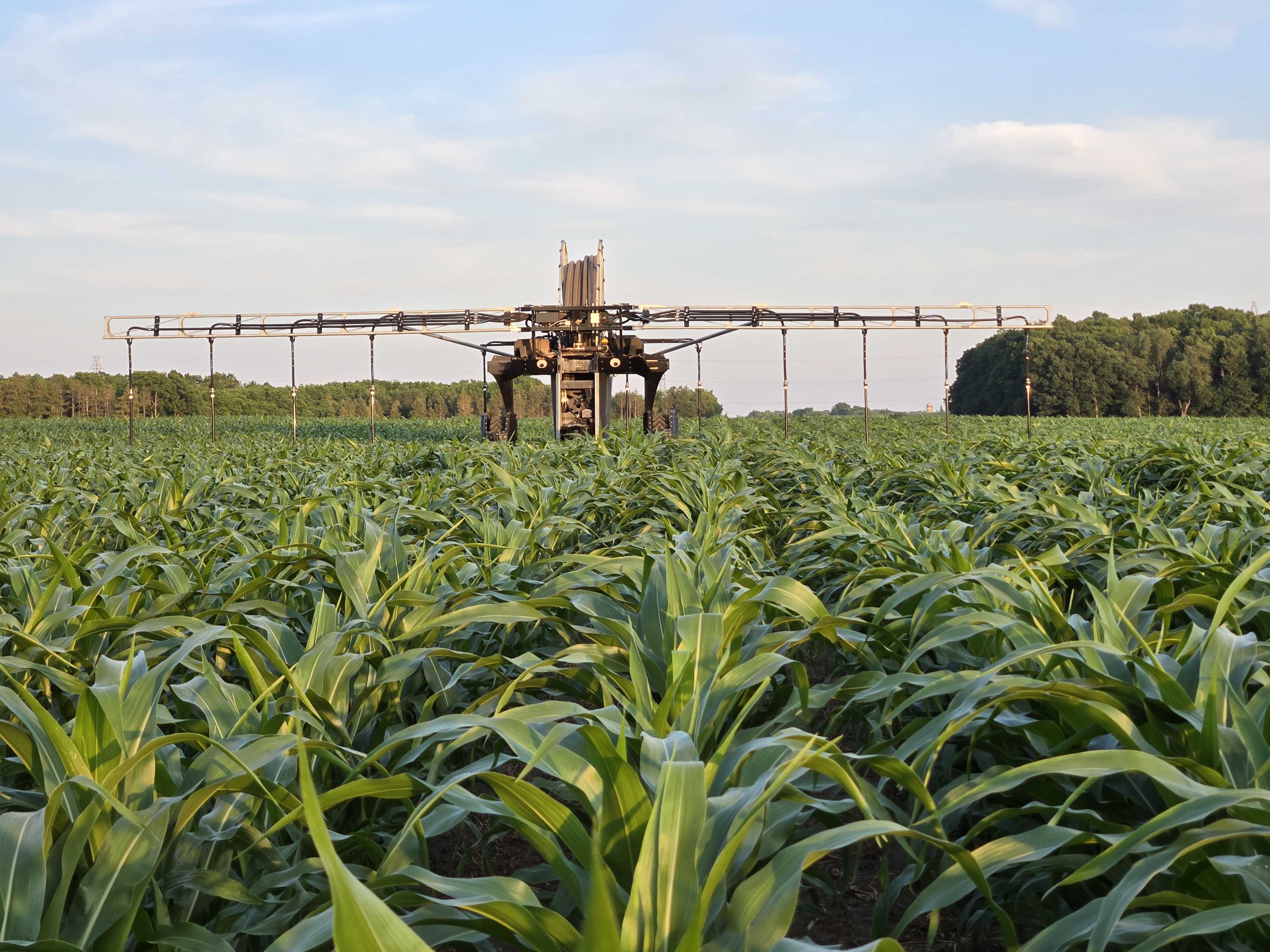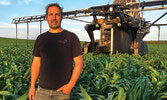By Mel Luymes
It is a Friday evening in early July at Hogendoorn Dairy, outside of Baden. The evening milking is finished. Family and friends are coming over to the shop and the kids are ripping around on four-wheelers on the paths made through the fields and woodlots.
But one employee on the farm will be working through the night in the corn field. In fact, it has been working day and night all week, and it hasn’t complained once.
Slowly but surely, the 360 RAIN autonomous irrigator moves up and down the corn rows and Y-drops a quarter inch of rain to the base of the plant. The 360 RAIN is a 3-wheeled diesel-electric driven 60-foot boom and hose reel, moving 7-8 inches a second, applying 7,500 gallons an acre at low pressure (below 12 psi). It runs almost silently and, using half a gallon of diesel an hour, one tank gives him over 30 days of run time.
The RTK planting data and the field boundaries are loaded into the software and create its path, so it can work even in irregularly shaped fields. It lays its 3-inch hose and runs the six outermost drops on the outgoing pass, then picks up the hose and runs the six inner (rear) drops on its way back. This means it isn’t spraying on the hose, and the unit isn’t driving on wet ground. The team also designed the unit to spread from the bottom of a hill to the top, so that if there is some excess water running downhill, the unit won’t be driving in it.
It turns on the headland and positions itself for the next 24-row swath (the same width as the planter). And with a 10-foot-high boom and 7-foot clearance under the frame, it can run through corn all season long.
“It is everything it is cracked up to be,” says Kees Hogendoorn, who was one of the first farmers in Ontario to get one of the robots. The unit was delivered in March and set up by the team from Grand River Robotics, the local dealer. Three other (dairy) farmers also jumped on this much-anticipated robot for spring 2025.
It takes about four days to do 100 acres, and, between the (few) rains, the unit has spread 3,000,000 gallons of manure over 500 acres of corn so far. It has another 180 acres to do to finish the field, says Kees. And then it can repeat the fields or move on to 30-inch soybeans. Before the corn was planted, the unit was applying onto some rye ground. With flat fan attachments, the unit can give complete coverage across solid-seeded crops.

Behind the barn, a 2,000,000-gallon pit is used to mix 1/3 manure (from another pit) with 2/3 water (from a well pumping 200-300 gallons a minute). It is agitated once a day and a 400 HP Cornell pump is running continuously, delivering through the underground pipes to the 360 RAIN unit. The pit is also instrumented as the unit’s base station.
The farm has already been plumbed for irrigation. With 10,000 feet of pipe underground and risers every 400 feet, they can move water, and manure-water, anywhere around the farm. The Hogendoorns started with travellers several years back and then purchased a pivot, and then another. They have long been looking for a way to get manure onto corn during the season.
They learned the hard way that manure water cannot go through the pivot, no matter what filters. “Sure we tried it, but then there are only 260 nozzles to unplug, and you’re covered in sh*t after the first one,” says Kees, shaking his head. Unlike a pivot or a traveller, the 360 RAIN uses low pressure, delivered at the ground and doesn’t use nozzles, so it is perfect for in-crop manure application.
Typically, they would draw down the manure pits in the spring and apply manure pre-plant with a drag line (pumping at 2000 gallons a minute, 10 times what the 360 RAIN uses). But this year they didn’t have to bother with it. They planted the corn earlier and the 360 RAIN started running in the back field when the corn was only a few inches tall.
Moving the unit to the front fields was a bit of a pain, admits Kees. Someone needs to be walking with it at all times, pressing a button and steering occasionally. “There were definitely some improvements to be made,” he says. Already, that issue has been addressed, says Jamie Elisen, who does sales and support for 360 RAIN with Grand River Robotics.
There are also adjustments that Kees needed to make to his fields and planter set-up. The unit needs extra space from trees for the boom to clear, and he thinks it wouldn’t hurt to widen tramlines for the tires and for the sprayer, especially on sidehills. Headland areas may be an ongoing challenge. He may end up moving down to 60 foot headlands and/or using clear paths for the unit so that it won’t need to trample them.
Walking through the corn that the unit irrigated three weeks ago, Kees is really happy with the crop so far. With his rolling sandy fields, and after missing several rains in June, his crop is taller and greener than the neighbouring fields. And he saved on fertilizer to boot.
The first year with the unit was a learning curve and it is a small group of people in Ontario learning together. Grand River Robotics hosted two demo days on July 10 and 11, with 160 people attending. There are several more farmers chomping at the bit to invest the half million dollars for a unit. Farmers would need to have a good chunk of acres accessible around a manure pit to make the system work, whether owned or with an agreement.
Jamie Elisen admits there are the typical start-up issues, but nothing that can’t be solved. The unit does best with lower dry matter; one of the Ontario farms had issues with too much solids in the manure. They installed a macerator to help break the solids up, for example.
While they are all dairy farmers for 2025, he says there was a tremendous amount of interest from hog farmers at the Pork Congress trade show as well. Jamie says it is a good solution for farmers that have at least 200 acres, and can pipe the manure around to various other fields as well.
In the case of the Hogendoorns, they already had the pump and pipe infrastructure set up for their pivots. They were sold on the benefits of irrigation on their sandy soils and the added benefit of manure application was a no-brainer for them.
Kees (Sr.) and Tineke Hogendoorn, came from the Netherlands with their two teenaged children in 1995. They wanted to farm and didn’t see much of a future in Europe. They settled on the farm in Baden and grew it over the years. Tragically, their daughter Karla Hogendoorn-Murray passed away when she was only 36 years old. The family keeps a path to the cemetery, so they visit her.
Kees and his wife Amanda went to high school together and now have three sons: Cole (16), Quinton (14) and Grayson (7).
The family milks about 450 cows and hasn't shied away from automation. Finding good people to work (and stay working) on the farm is an ongoing challenge and so they are looking for anything that will save on labour. They use sand bedding and have two Daritech One Shot sand separators for the manure; there are two automated udder cleaners on their 60-cow rotary parlour. With just two people, they can milk 300 cows an hour.
Before we snapped these photos, on the 4th of July, Cole jumped up on the robot to attach two large googly eyes. The Hogendoorns also put eyes on their Lely Juno automatic feed pusher to help it find its way.
“It got lost a few times and couldn’t find its charger,” says Quinton, keeping a serious face, “so we gave it some eyes.”
The Hogendoorns are happy with the 360 RAIN unit. The corn looks incredible, and the manure pits have plenty of capacity for the summer.
“My father kept saying it would never work, but now that he’s seen it going here, he’ll try to sell you one,” Kees laughs. “He’s never wrong,” he adds, it’s just that his father changed his mind with new evidence, and a whole lot of Youtube videos.
As the family gets back to the shop gathering, the 360 RAIN continues diligently up and down the corn rows. It is hard to predict where the technology will go next, but with four units now sold in Ontario and a few months of experience under their belts, it looks like the 360 RAIN will be an important tool for farmers going forward. ◊


